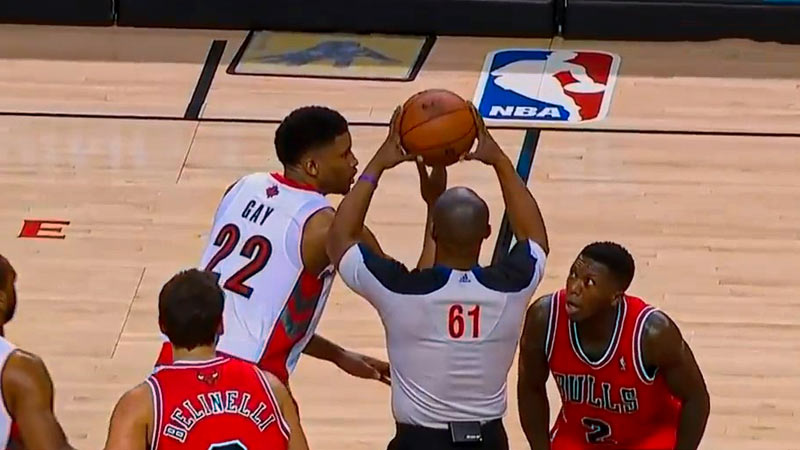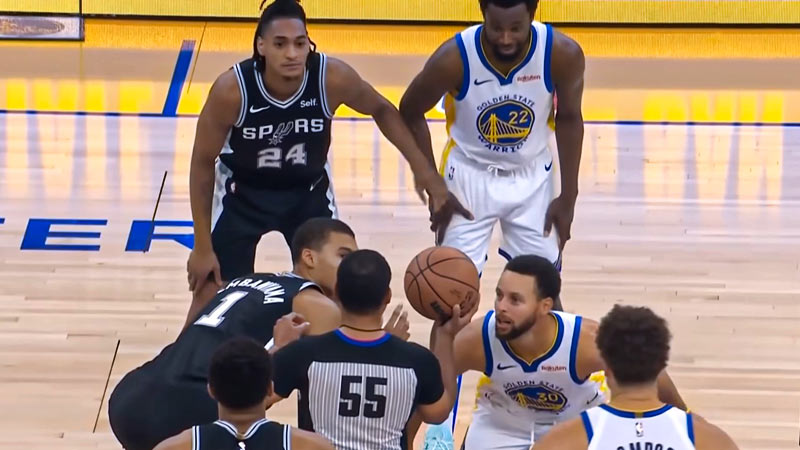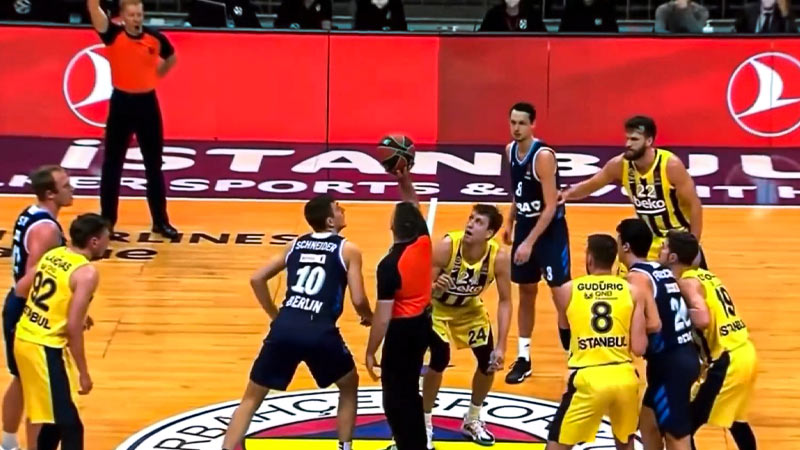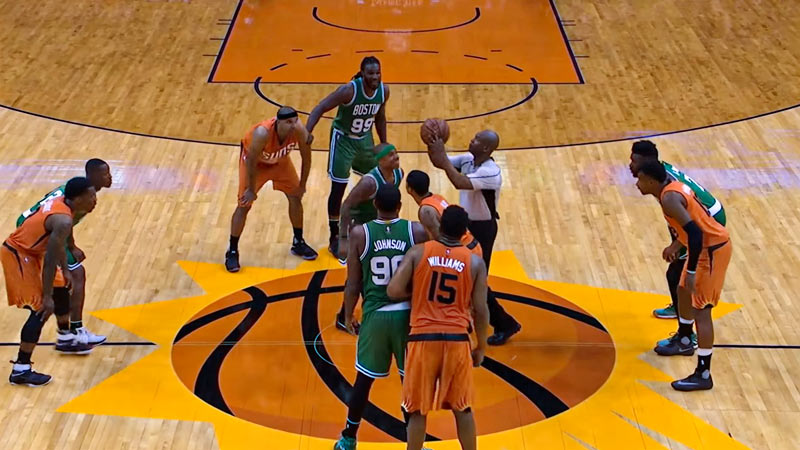Basketball is a sport renowned for its fast pace, skillful maneuvers, and numerous rules. One intriguing aspect of the game is the jump ball, a unique procedure that occurs at the beginning of each game and can take place during certain game situations.
In this article, we will delve into what is jump ball in basketball, examining its purpose, rules, and its impact on the game.
What Is Jump Ball In Basketball?
A jump ball is a method used to start a basketball game. It is employed at the beginning of the game, after the halftime break, and in various situations where two opposing players have simultaneous possession or the officials are uncertain about which team should be awarded possession.
The jump ball serves as a fair and unbiased way to determine which team will have the initial possession of the ball.
During a jump ball, two players, one from each team, are selected to participate. They stand facing each other in the center circle of the court, which is also known as the jump circle.
The referee tosses the ball into the air, and the two players attempt to gain control of it by leaping and tapping it to a teammate. This act of tapping the ball is referred to as “tipping” the ball.
The players participating in the jump ball are typically taller players, such as centers or power forwards, due to their height advantage and ability to reach the ball effectively.
However, in certain situations, coaches may assign other players to participate based on their jumping ability, agility, or strategy.
What Are the Rules of Jump Ball?

The rules of the jump ball in basketball outline the specific procedures and guidelines to ensure a fair contest. Here are the key rules regarding the jump ball:
Participation
Two players, one from each team, are selected to participate in the jump ball. Typically, taller players like centers or power forwards are chosen due to their height advantage. However, coaches may assign other players based on their jumping ability or strategy.
Jump Circle
The jump ball takes place in the center circle, also known as the jump circle or midcourt circle, at the center of the court.
Starting Position
The two players participating in the jump ball must stand facing each other within the jump circle, with their feet inside the circle and in their designated positions.
Referee’s Toss
The referee tosses the ball into the air vertically from the center of the jump circle between the two players.
Ball Contact
The players must wait until the ball reaches its highest point or is contacted by one of the players before attempting to gain possession.
Tipping the Ball
Instead of catching the ball, the players must tap or tip it to a teammate. This action of tapping the ball is known as “tipping.”
Possession
After the ball has been tipped, any player from either team may attempt to gain possession of the ball.
Violations
Certain violations can occur during the jump ball, resulting in turnovers or a redo of the jump ball. Examples of violations include catching the ball instead of tipping it, leaving the designated position early, or committing any other rule infractions.
Alternate Possession
After the initial jump ball, possession alternates between teams for subsequent jump balls that occur during the game, unless a specific rule states otherwise (e.g., when a held ball situation occurs).
Shot Clock Reset
In some leagues, such as the NBA, a jump ball that initiates a new possession results in the shot clock being reset to 14 seconds instead of the full 24 seconds.
It is important to note that basketball rules can vary slightly depending on the league, level of play, or organization governing the game. These rules ensure a fair and competitive environment while determining the initial possession of the ball.
When Do Jump Balls Happen?

Jump balls occur in specific situations during a basketball game. Here are the main instances when jump balls happen:
Start of the Game
A jump ball takes place at the beginning of the game. It determines which team will have the initial possession of the ball. The two players participating in the jump ball represent their respective teams, and the team that gains possession gets the first offensive opportunity.
Start of Overtime
If a game goes into overtime due to a tie at the end of regulation, another jump ball occurs to determine the initial possession in the extra period.
After Halftime
Similar to the start of the game, a jump ball occurs after halftime. It serves to determine which team will have the first possession in the second half.
Simultaneous Possession
When two opposing players from different teams gain simultaneous possession of the ball, the officials may call for a jump ball to determine which team should be awarded possession.
This can happen when two players grab the ball at the same time or when they both have a firm grip on the ball, leading to a tie-up.
Lodged Ball
If the ball becomes wedged or lodged between the rim and the backboard, a jump ball is used to decide which team will gain possession.
Alternating Possession Situations
In certain situations where possession alternates between teams, such as jump ball situations resulting from held balls or specific violations, a jump ball may be used to determine which team will have the next possession.
It’s worth noting that the specific rules regarding jump balls can vary slightly depending on the league, level of play, or organization governing the game. However, the purpose remains consistent: to determine possession in a fair and unbiased manner.
What Player Takes Jump Balls?

Typically, taller players are selected to take jump balls due to their height advantage and ability to reach the ball effectively.
Centers or power forwards, who tend to be taller and have strong leaping ability, are commonly chosen to participate in jump balls. Their physical attributes make them more likely to secure possession of the ball after the jump.
However, it is important to note that there are no strict position requirements for participating in jump balls. Coaches may choose other players based on their jumping ability, agility, or strategic considerations.
In certain cases, teams may assign players from different positions, such as agile forwards or even guards with good leaping ability, to compete in jump balls.
Ultimately, the decision on which player takes jump balls depends on the coach’s strategy, the team’s roster, and the specific attributes and skills of the players available.
What Is a Jump Ball Violation?
A jump ball violation occurs when a player involved in a jump ball commits an infraction or fails to adhere to the specific rules governing the procedure. Here are some common jump ball violations:
Catching the Ball
Instead of tapping or tipping the ball, if a player catches the ball directly during a jump ball, it is considered a violation. The player must make contact with the ball by tapping it to a teammate rather than securing it with their hands.
Leaving Position Early
The players participating in the jump ball must remain in their designated positions until the ball is contacted by one of the players or reaches its highest point. If a player leaves their position prematurely, it is considered a violation.
Illegal Contact
Engaging in any form of illegal contact during the jump ball, such as pushing, grabbing, or obstructing the opposing player, is a violation.
Double Foul
If both players involved in the jump ball commit a foul simultaneously, it results in a double foul. In such cases, the jump ball is repeated with different players selected to participate.
Interference
Interfering with the jump ball by another player who is not participating or attempting to gain possession is a violation. Players not involved in the jump ball must maintain a reasonable distance and cannot disrupt the process.
Delay of Game
Deliberately stalling or delaying the jump ball by one of the participants, such as intentionally not making contact with the ball or refusing to jump, can be considered a violation.
When a jump ball violation occurs, possession of the ball is awarded to the opposing team. The violation results in a turnover, and the opposing team gains possession, typically taking the ball out of bounds from the spot where the violation occurred.
It is important to note that specific rules and interpretations may vary slightly depending on the league, level of play, or organization governing the game.
The jump ball violation rules ensure fair play and adherence to the proper procedures during this aspect of the game.
FAQs
Can any player participate in a jump ball, or are there specific positions designated for this role?
While it is common for taller players, such as centers or power forwards, to participate in jump balls due to their height advantage, there are no strict position requirements. Coaches may assign players based on their jumping ability, agility, or strategic considerations.
What happens if a player commits a violation during a jump ball?
If a player catches the ball instead of tapping or tipping it during a jump ball, it is considered a violation. The opposing team is then awarded possession of the ball as a turnover.
Can a jump ball occur during the game apart from the beginning and after halftime?
Yes, jump balls can occur during the game in specific situations. For instance, if opposing players gain simultaneous possession, or if the ball becomes lodged between the rim and the backboard, a jump ball is used to determine which team gains possession.
What happens if both players participating in a jump ball simultaneously touch the ball, resulting in a tie-up?
If both players participating in a jump ball simultaneously touch the ball, it leads to a “held ball” situation. In this case, possession of the ball is awarded to the team that has the possession arrow in their favor.
The possession arrow is typically determined by a pregame coin toss.
Why is the shot clock reset to 14 seconds for a jump ball that initiates a new possession in the NBA?
In the NBA and some other leagues, the shot clock is reset to 14 seconds instead of the full 24 seconds when a jump ball initiates a new possession.
This rule change was implemented to promote a faster pace of play and increase scoring opportunities, making the game more exciting for fans.
Final Words
So, now you know what is jump ball in basketball. The jump ball is an essential aspect of basketball, determining the initial possession and resolving uncertainties about possession during certain game situations.
Its execution adheres to specific rules to ensure fairness and provide an equal opportunity for both Ms. Understanding the purpose and mechanics of the jump ball adds depth to our appreciation of the sport and highlights the importance of gaining control of the ball from the very beginning.







